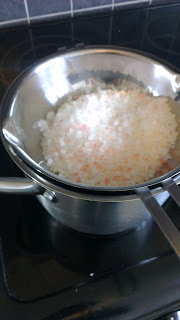Finally a blog that's not food or knitting. A long time ago I was given a candle making kit for Christmas. Being clumsy and having a never ending fear of ruining things I've never used it. And it's always eaten away at me, the idea that someone bought something for me that I've not used. Talk about stuck between a rock and a hard place, guilt of not using something but also being afraid of ruining it if I do.
So, I was in Ikea with my mum and we were looking at the candles and there were candles in glasses and some really nice glass bowls (what I can only describe as sweet dishes). They were there to hold night lights, but we thought it was a real shame they weren't filled in with a full candle.
Knowing I had a kit, and with my casual "sure, I can do that" attitude (it's normally used more for when we see something being cooked on tv, not something I have no experience with), I bought a double boiler in the kitchen department and headed home. After a quick internet search, and minor panic, I set about making candles.
 |
| Pretty bowls. |
Equipment
Heating wax is really easy, the only thing you have to watch out for is the wax reaching it's flash point and bursting into flame.
Wicks. They come in lots of types, made of different materials, waxed and unwaxed, but the two main types are the ones with a stand and the ones without. My kit came with the wick without a stand, if I wanted to use it with the moulds I would have to thread it through the mould, use "mould seal" (or blue tack) at the base and tie it up at the other. Because I don't have an end to thread the wick through I used a wick with a base so it would stand up.
Wax. There's loads of wax out there, bees wax, paraffin wax, soy wax. My kit came with paraffin beads so that's what I used, but I think soy wax is meant to have a better burn.
Embelishments. To colour and scent my candles I went to hobby craft and bought a block of dye and a bottle of oil. Not all essential oils can be suspended in wax so make sure it says on the bottle if it's suitable. Alternatively you can mix some scent in a small amount of molten wax in something like an egg cup, and if when the wax solidifies again there is oil in the container then it's come out of solution and isn't suitable.
Method
Once you've got everything ready it's fairly simple. To work out how much wax you need, just remember that 1ml =1g. I filled my containers with water then poured that into a measuring jug. I then put the equivalent amount of wax (plus a little for just in case) into the double boiler over gently boiling water, but without touching the water. Slowly the wax should melt, mine possibly a bit more slowly because I wasn't sure how fast it would melt.
Once melted, add the colour and scent. Add the colour slowly, you can always add more but not take away. The colour will only show properly when it's solid so you may have to cool small amounts to check it. I added a couple of tea spoons of oil, but the bottle should give you an idea of how much you need to add.
Pour molten wax into containers, holding some back, and insert wick. As the wax cools it may form a ring, break the wax and top up with the reserved wax. I didn't quite catch this so I tried to fill in the dimple and it just looked a bit rubbish, hopefully when they're used the wax will melt and even itself out a bit.
So, the finished product, although not perfect, was exactly what my mum was after, and the fact she forgot to take them last time I saw her I'm sure was a memory failure and not a comment on the candles.
This was actually kind of fun, when I wasn't worrying about things exploding. And it was nice to give someone something that wasn't edible for a change, and the bowls can easily be reused. I think I'll be making more candles with the moulds in my kit (so if you know me, you may be getting one for Christmas!)
Jam update: Mum did remember to take a jar of jam with her, which her and dad practically finished in two sittings. Goes well with brie apparently.

















